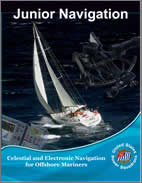 |
Junior Navigation is the first in a two-part program of study in offshore navigation, followed by the Navigation course. It is designed as a practical course.
Topics covered include: precise time determination, use of the Nautical Almanac, taking sextant sights of the sun, reducing sights to establish lines of position, special charts and plotting sheets for offshore navigation, offshore navigational routines for recreational craft, electronic and computerized offshore navigation.
In Junior Navigation, the student will continue to use GPS as the primary position sensor, as they learned to do in Piloting and Advanced Piloting. However, the offshore environment poses many different elements for consideration by the Navigator. Ocean currents, wind, and sea state all affect a vessel's performance over the longer passages. Also, visible terrestrial landmarks are no longer available to the navigator as reference points. In the Junior Navigation course, the student will learn to substitute celestial objects such as the sun as reference points. The course begins with the study of celestial navigation, teaching the student to take sights on the sun with a marine sextant and derive a line of position from that observation. Next, the student will apply the principles learned in Advanced Piloting, and plot a running fix from two sun sights taken about four hours apart. Once the student has learned the basics of celestial sight reduction, the course continues with planning, positioning, and checking ones position in the offshore environment, using both electronic and celestial tools.
Contact Education Officer Kevin Abbey Email 
STATUS: Next class starts March 15, 2017 from 7-9 pm at the CT Fire Academy Training Building, 34 Perimeter Road, Windsor Locks, CT. To view the course poster, click here. |